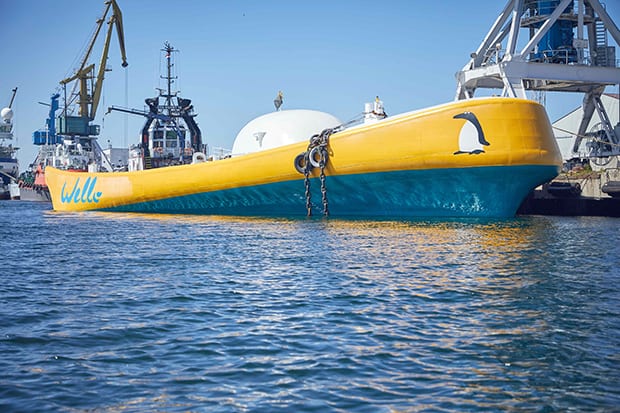Oilfield service providers are increasingly moving beyond oil and gas development work, and into renewable energy projects, according to a study conducted by Rystad Energy, an independent research and business intelligence company that provides data, tools, analytics, and consultancy services to the global energy industry.
In findings released on Oct. 29, Rystad said that oil and gas service company revenue from non-exploration and production activities has been growing over the past five years. It accounted for 27% of revenues in 2018, up from 22% in 2014. Additionally, Audun Martinsen, head of oilfield services research with Rystad, said if pure-play contractors in the drilling, well services, and seismic business fields were removed from the equation, non-upstream activities accounted for nearly 30% of revenues last year. And the firm expects that trend to accelerate over the next decade.
Companies Rebrand and Expand Offerings
As one example, Rystad pointed to recent changes at Baker Hughes Co., a major player in the oil and gas industry. In September, GE reduced its ownership stake in Baker Hughes from 50.4% to 38%. About a month later, Baker Hughes rebranded itself as "an energy technology company, with a diverse portfolio that spans the entire energy value chain." The company said the "new name and brand better reflect its current and intended principal business operations and diversified portfolio."
On Baker Hughes' website, CEO Lorenzo Simonelli said, "Managing carbon emissions is a fundamental priority for the industry and a strategic focus for our business." Among the low-carbon technologies the company is peddling are geothermal exploration and generation, which seems like a natural crossover for an experienced oil and gas developer; waste heat recovery systems for gas turbines; advanced inspection services, which includes drones suitable for a variety of solar, wind, nuclear, and other conventional power plant applications; a 100% hydrogen-fueled Nova LT gas turbine generator; and industrial-scale carbon capture, use, and storage projects.
Likewise, Saipem, a leading oil and gas engineering, drilling, and construction contractor, has seen its oil-based backlog decrease from 50% in 2016 to about 33% this summer, according to Rystad. The firm said clean energy projects, including offshore wind, solar, geothermal, and biomass-related jobs, could make up 60% of Saipem's portfolio in the future.
Saipem announced on Oct. 29 that it was teaming with Wello Oy, a Finnish company operating in the ocean-wave energy conversion sector, to deploy WEC (wave energy converter) Penguin technology (Figure 1) for the production of energy from marine waves. Francesco Balestrino, renewables and green technologies business development manager of Saipem's XSIGHT division, said, "[T]his project represents Saipem's first opportunity to perform a project in the marine energy field that is consistent with our diversification strategy. It also proves Saipem's commitment to provide its clients with new sustainable solutions."
TechnipFMC–another global leader in oil and gas projects, technologies, systems, and services–announced on Aug. 26 that it plans to separate into two independent publicly traded companies. One, a fully integrated technology and services provider, continuing to drive energy development; and the other, a leading engineering and construction player, poised to capitalize on the global energy transition.
In a press release, TechnipFMC said the spinoff company will be uniquely positioned to capture liquefied natural gas opportunities. In addition, the new company is expected to benefit from "future growth opportunities in biofuels, green chemistry and other energy alternatives."
Energy Transition Behind the Moves
Rystad's Martinsen suggested the shift taking place across the industry is a sign that the energy transition is gaining momentum. "In the next decade, this trend is likely to crystallize further, with more oilfield service companies expanding into other energy services to adapt to the winds of change and to gain a first-mover advantage in the emerging clean energy service market," he said.
"For service companies, it will be a more lucrative journey to get exposed to a fast-moving energy market, like in Asia-Pacific, where renewable [capital expenditures] will overtake upstream investments as soon as next year," Martinsen added.
In a separate study released on Oct. 28, Lux Research, a provider of tech-enabled research and advisory services, said the shift toward a low-carbon economy and stricter emissions standards was one of the "driving forces behind the reinvention of the global oil and gas industry." Lux said the challenges facing oil and gas leaders are inevitably leading toward a tech-focused future for an industry that has traditionally resisted massive or rapid change.
"We expect that in order to meet these challenges in the digital age and successfully scale global operations to meet a new stream of demand, we will see a new breed of ‘tech' oil companies, the disruption of traditional service companies by major software giants, the creation of data marketplaces, and more operator-to-operator digital collaborations," Harshit Sharma, an analyst with Lux and the lead author of the report, said.
–Aaron Larson is POWER's executive editor (@AaronL_Power, @POWERmagazine).

